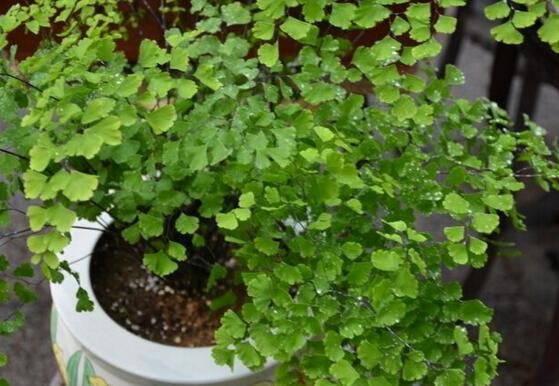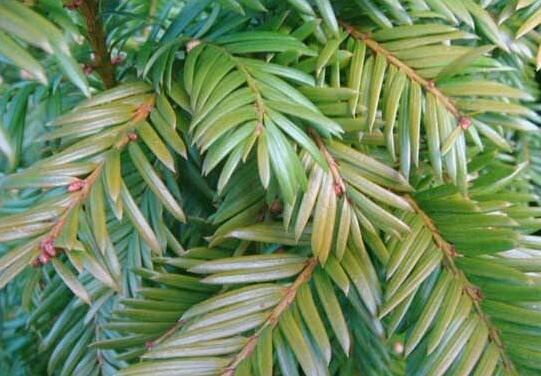How to raise Dryopteris in winter, the temperature is above 10 degrees / increase light to avoid strong light / stop fertilization
Through the cultivation method of Dryopteris, we know that it likes a warm and humid environment, but because its cold tolerance is relatively general, how to maintain it in winter has become a concern for many flower friends. because it is related to whether the leaves of Dryopteris can remain fresh and green, how to keep the fern leaves fresh in winter? The following editor will tell you some tips.
How to raise Dryopteris in winter
1. The temperature is above 5 degrees

When maintaining in winter, the first thing to consider is heat preservation, because when the temperature is lower than 5 degrees, Dryopteris is prone to frostbite, which will make the leaves wither and fall off, so effective heat preservation measures must be taken. Flower friends in the south can cover the fern with thermal insulation plastic film, while flower friends in the north had better move the fern indoors.
2. Light / bright light
Dryopteris is a shady plant, so it is generally kept in a semi-shady place in spring and autumn, but it needs to be brighter in winter, and can be increased in the morning and evening, but it needs to avoid the sun at noon. Direct sunlight should not be ignored because of the low temperature.
3. Watering / reducing times
Because the water evaporates slowly in winter and the plant absorbs water very slowly, how to raise Dryopteris in winter in watering? The answer is to reduce watering, when you see the soil surface white, appropriate watering, otherwise as little watering as possible, must not be watered as frequently as other times, the method can refer to the detailed description of how to water Dryopteris.
4. Fertilization / cessation of fertilization
If watering needs to be reduced, fertilization needs to be stopped, because Dryopteris itself does not have a high demand for fertilizer, and it only needs to apply thin fertilizer every month during the growing period, so it is necessary to stop fertilization in the dormant state in winter. otherwise, fertilizer damage will easily lead to poor temperature and soil structure.
Key points for maintenance of Dryopteris in winter
1. Position. Choosing a suitable location can reduce the difficulty of maintenance and avoid moving the fern back and forth. Usually, the fern can be placed in places where the light is scattered and out of sunlight in winter, such as the north balcony or the window.
2. Pay attention to humidity. When indoors, the temperature is higher and the air humidity is lower, while Dryopteris is more afraid of dry air, so in order to improve air humidity, you can spray some water around the plant, or appropriately increase the ventilation of the following environment every day to avoid leaf curling caused by too low humidity.
3. The temperature should not be too high. Although it is afraid of frostbite in winter, the temperature can not be controlled too high. it is ideal to keep the temperature above 10 degrees. It can not only avoid freezing damage, but also keep the fern growing well and make the leaves bright and green.
How to raise Dryopteris, how to cultivate Dryopteris and matters needing attention / avoid drying and strong light
Dryopteris can not only observe the leaves, but also raise harmful substances such as formaldehyde and nicotine at home, and the methods of maintenance and management are relatively simple, so more and more people are going to raise a few pots at home, so is it easy to keep them at home? How to raise Dryopteris? Today we will learn about the breeding methods and points for attention of Dryopteris Dryopteris.
Is Dryopteris easy to raise?
Dryopteris Dryopteris is one of the plants that are easy to raise. It has general requirements for soil, temperature, water and fertilizer, but higher requirements for light and humidity to ensure that its environment is not too dry and the light is not particularly strong, and then use suitable soil. And reasonable watering, fertilization can raise very well.
How to raise Dryopteris
In the growing environment, Dryopteris prefers fertile, loose and permeable soil; in light, it likes places where the light is bright but not too strong; in water, it likes a moist environment; in temperature, its leaves need more than 5 degrees to be green, so we should try to create such an environment for it during conservation.
Culture methods and matters needing attention of Dryopteris Dryopteris
What kind of soil does Dryopteris use?
In the choice of soil, the lowest requirement is good drainage and loose, and there are two most suitable soils, the first is to use garden soil, rotten leaf soil and fine sand, the proportion is 40%, 50%, 10%; the second is to use peat soil, rotten leaf soil, fine sand mixture, the proportion is 40%, 40%, 20%.
Note: no matter which kind of soil is used, you must pay attention to disinfection before planting. The easiest way is to dry in the sun for 1-2 days, and if possible, you can use carbendazim or potassium permanganate solution to achieve disinfection.
Second, lighting requirements
Dryopteris likes a bright environment with no lack of light, and it is afraid of direct sunlight, so it is best to keep it in the east or north windowsill when raised at home, so as to prevent it from being exposed to the sun. If you are kept in the hospital, you should block out more than 50% of the sun in summer.
Note: when the light is too strong, the leaves of Dryopteris may become zoom and dry, so we must not raise it in full light, but in the breeding methods and precautions of Dryopteris, we should also pay attention to the lack of light, if the light is too dark will make the leaves thinner, thin, unable to play the efficacy of Dryopteris and the role of ornamental value.
3. Suitable temperature
The most suitable temperature for Dryopteris is 10-20 degrees, but as long as the temperature is above 5 degrees, its leaves can remain green, but often below 5 degrees may be frostbitten, so keep warm in winter. In summer, you need to spray more water to lower the temperature.
Note: in autumn or winter, the temperature difference between day and night is large, at this time how to raise Dryopteris? It is suggested that flower friends move it indoors, which can not only control the temperature within a suitable range, but also reduce the excessive temperature difference and lead to the yellowing of fern leaves.
Fourth, watering method
When watering, you should try to keep the soil moist, because Dryopteris is a plant that likes a humid environment, so it can be watered once a day or two during the growing period. If it is a hot summer, it can be watered once in the morning and evening, not too much each time.
Note: if often not watered, the edges of the leaves will dry up and curl, so watering should be avoided. Although there are many times of watering, there must be no stagnant water in the soil. Try to water it by sprinkler irrigation.
5. Fertilization skills
The demand for fern on fertilizer is not high, as long as it can be applied with thin fertilizer and water once a month, because Dryopteris is an indicator of calcareous soil, so less calcium fertilizer can be applied when fertilizing, which can make the fern grow better.
Note: when the summer temperature is relatively high, you need to stop fertilization and wait until the temperature is cool before applying organic fertilizer. In winter, there is no need to apply fertilizer, especially when the temperature drops below 5 degrees, and fertilizer should not be sprinkled on the leaves.
How to raise Dryopteris and the method of raising Dryopteris
A perennial herb called Dryopteris because of its slender stems and color like wire. The leaf bundles of Dryopteris Dryopteris are indicators of calcareous soil. What it fears most is dryness and strong light, and we need to keep it in a place where the sun can't shine directly. What the editor brings to you today is about how to raise Dryopteris and the breeding methods of Dryopteris. I hope it will be of some help to flower lovers.
[growth habits of Dryopteris Dryopteris] Dryopteris likes loose, permeable and fertile calcareous sandy loam, and the cultivated soil can also be mixed with loam, rotten leaf soil and river sand when potted. It often grows on flowing streams or dripping cliffs, and is an indicator of calcareous soil. The most suitable temperature for growth is between 21 and 25 degrees during the day, and between 12 and 15 degrees at night, and the temperature above 5 degrees can keep its leaves fresh green, but if it is lower than 5 degrees, it will cause frost damage to its leaves. It likes bright scattered light and is most afraid of the direct sunlight on it. It should be placed indoors in a place with bright light. In this way, it can grow even if it is kept for a year.
[cultivation method of Dryopteris] because the growth rate of Dryopteris is relatively fast, the basin will be changed every spring, and the rotten leaf soil used in the basin soil should be prepared with a small amount of brick dust and wood ash powder, and during its growing period, it needs sufficient oil to water and spray water. If the basin soil is dry and wet, its leaves will easily turn yellow. We can apply fertilizer once every half a month, and we should taboo to defile the foliage when applying fertilizer. And in the midsummer to avoid the exposure of strong light, so as not to cause the scorching of the leaf edge, it is necessary to move to indoor maintenance in winter.
Fertilizer and water management: Dryopteris likes a humid environment, so it needs adequate watering during the peak growing season. Besides keeping the basic basin soil moist, we should also pay attention to the high air humidity. When the air is dry, we can sprinkle water around the plant. Especially in summer, water should be watered 1-2 times a day. If it is lack of water, it will cause leaf shrinkage. Watering is also taboo when the basin soil is dry and wet, so it is easy to make the leaves yellow, and we can apply thin liquid fertilizer to it 2-3 times a month. Do not defile the leaves when fertilizing, so as not to cause rotten leaves, because of the calcium-loving habits of Dryopteris, we can also add the right amount of lime and crushed eggshells to the basin soil, and the effect of calcium fertilizer will be better. Reduce watering and stop fertilizing it in winter.
[main value of Dryopteris] Medicinal: the whole grass has the effects of heat-clearing and detoxification, dampness and detumescence, as well as diuresis and gonorrhea, and generally has a very good effect on iron damage. Horticulture: because you like shade and have strong adaptability, it is easy to cultivate it. It is most suitable to be placed in perennial potted plants for viewing. Small potted plants can also be placed on a desk or on a coffee table. Larger potted plants can be used to decorate the windowsill of a shady room.
- Prev

How to water Dryopteris Dryopteris, watering method / watering time / water quality selection
Although the plant of Dryopteris is small, its growth rate is very fast, and it has a greater demand for water during the growing period, because it likes a humid environment, so we must pay attention to reasonable watering in daily management.
- Next

How to do yellowing of yew leaves? comprehensive consideration of five reasons / attached solution
Although the yew is a precious plant, the culture method of the yew is not as difficult as expected, but we also need to know some skills when planting, otherwise it may cause the yellowing of the leaves.
Related
- Fuxing push coffee new agricultural production and marketing class: lack of small-scale processing plants
- Jujube rice field leisure farm deep ploughing Yilan for five years to create a space for organic food and play
- Nongyu Farm-A trial of organic papaya for brave women with advanced technology
- Four points for attention in the prevention and control of diseases and insect pests of edible fungi
- How to add nutrient solution to Edible Fungi
- Is there any good way to control edible fungus mites?
- Open Inoculation Technology of Edible Fungi
- Is there any clever way to use fertilizer for edible fungus in winter?
- What agents are used to kill the pathogens of edible fungi in the mushroom shed?
- Rapid drying of Edible Fungi

